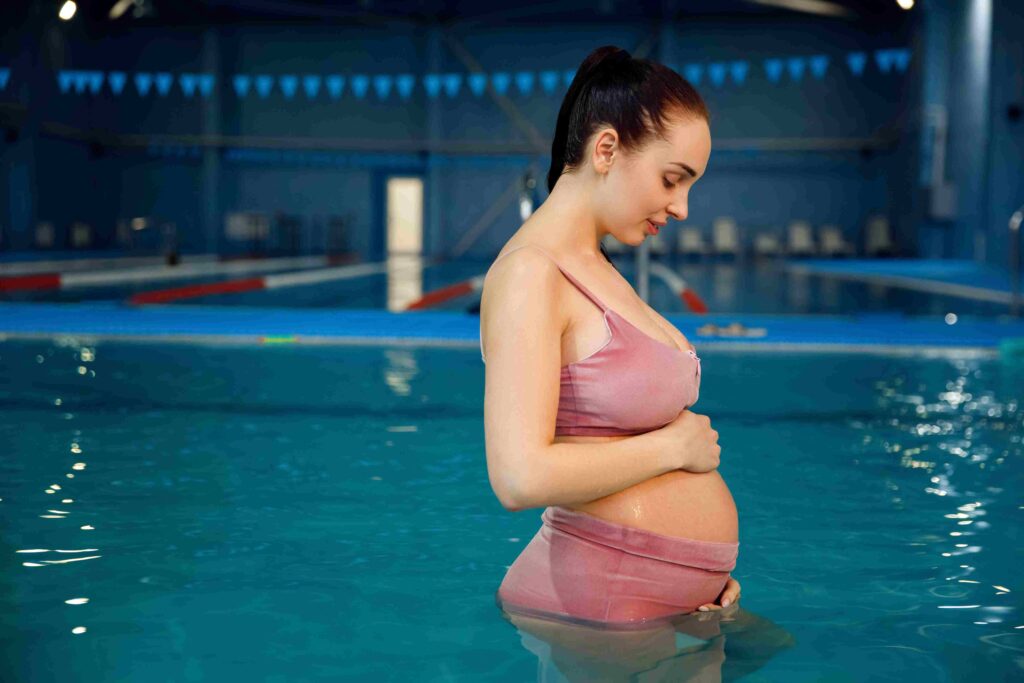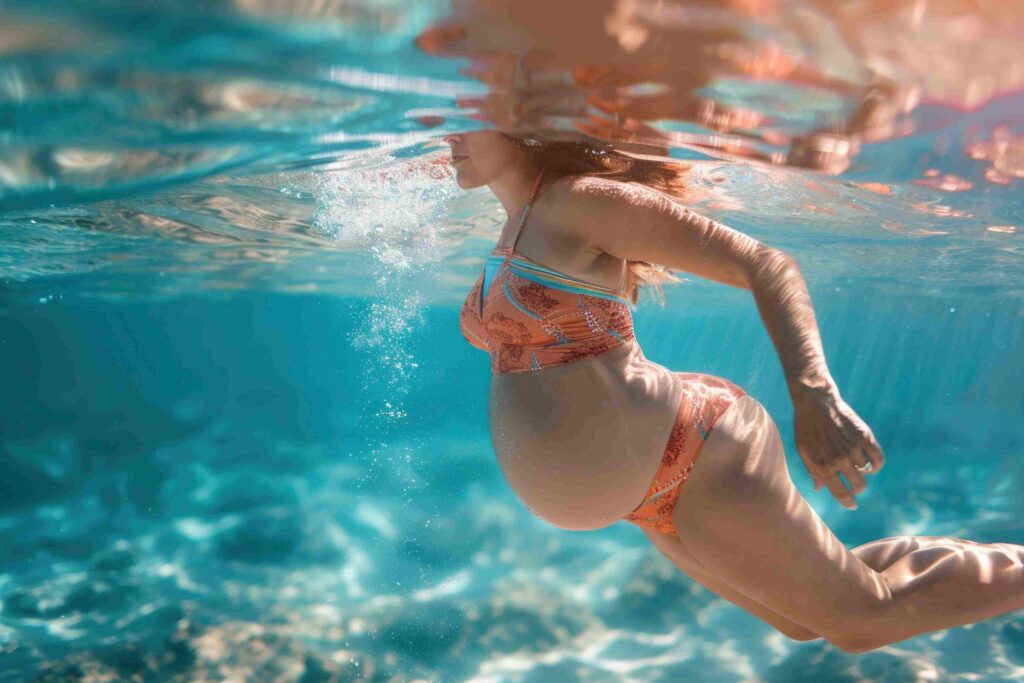It is well known that swimming is one of the best sports during pregnancy. The activities offer many benefits, including engaging major muscle groups, protecting joints and ligaments, and being low impact. Interaction with water has a beneficial effect on the expectant mother’s body and allows for timely preparation for childbirth. During swimming workouts, a woman’s muscles are toned while her body remains relaxed.
Medical experts consider swimming during pregnancy as one of the most gentle forms of physical activity, which is important for the body of the expectant mother. Exercising in water distributes the load on the body evenly, engaging nearly all muscle groups. The intensity of workouts depends on individual capabilities and may include short-distance swims or sets of exercise routines.

The Benefits of Swimming for Pregnant Women
Swimming pool visits by pregnant women have an undeniably positive impact on:
- the respiratory system, as diving and swimming activities help prepare for proper breathing during labor;
- the spine, since being in the water reduces pressure on the spine, helping to alleviate or prevent back pain;
- the cardiovascular system, resulting in improved blood circulation, stabilized blood pressure, increased elasticity of the heart muscle and blood vessels, and addressing issues with hypertension and varicose veins.
Additionally, movement in the water removes excess fluid from the body, reducing swelling.
Moreover, water aerobics allows you to burn more calories than regular physical activities without the risk of strains, helping to lose excess weight and boosting immunity. Swimming for pregnant women is beneficial for reducing anxiety levels, improving sleep, mood, and appetite.

Nuances of Swimming in the 1st Trimester
In the 1st trimester, a woman’s appearance may not have changed significantly, and no one but her may even be aware of her ‘interesting’ condition. This means there is no visual change to stop her from attending the pool even in her favorite two-piece swimsuit if she previously engaged in such activities as normal physical exercise. However, internal bodily changes have already begun, and doctors do not recommend swimming during the first 12 weeks of pregnancy.
These restrictions are due to the mucous plug, which prevents pathogenic microbes from entering the cervix, only beginning to form. At this stage of pregnancy, the risk of exposing the fetus to infectious pathogens is extremely high. Therefore, swimming during pregnancy should be postponed until the ‘golden period’ of pregnancy – the 2nd trimester.
Swimming in the 2nd trimester
This period is the most favorable time for water activities. The 2nd trimester of pregnancy is characterized by the absence of morning sickness, a small gain in weight, and good well-being. In the middle of carrying a baby, nothing prevents you from enrolling in a pool for prenatal aquafitness or, if possible, regularly going to the beach by the sea or river.
If a decision is made to go on vacation and even travel to another city, there are no contraindications for flights and train trips in the second trimester yet. However, before signing up for the pool, going to the sea, or deciding to swim regularly in the river, it is advisable to consult the gynecologist managing the pregnancy. With a complete picture of the expectant mother’s health, the doctor can decide whether this particular woman should swim during pregnancy.
Swimming in the 3rd trimester: Features
Swimming classes for pregnant women are permissible in the third trimester if there are no contraindications. However, the “golden time” of pregnancy is over, and as childbirth approaches, new bodily changes necessitate some restrictions. This includes water activities. Similar to the first trimester, they are linked with the need to minimize the risk of infecting the fetus while in open water bodies or swimming pools.
This risk is due to the mucus plug, which is meant to prevent pathogenic microbes from entering the cervix, starting to detach, reopening the channel and significantly increasing the risk of bacterial infection to the unborn child. Specialists recommend that, in the absence of contraindications, activities be continued in the third trimester up until the 36th week, as the plug usually detaches a month before birth.

Doctors’ Recommendations
Expert advice on swimming during pregnancy includes recommendations concerning the choice of a wellness center, the duration of workouts, and other nuances. Doctors recommend paying attention to:
- how far the fitness and wellness center is from home – the closer, the better;
- which water purification methods are used – priority should be given to facilities using ultrasound, ozonation systems, or high-frequency electromagnetic pulses. Ideally, the pool should be filled with seawater, but the cost should be taken into account;
- whether there’s a convenient entrance to the water – are there handrails, a gentle slope available;
- what the temperature setting is – a comfortable temperature for pregnant women’s activities is between 28 to 31 degrees Celsius.
Aside from maintaining a swimming frequency of 3-4 times a week for pregnant women, starting with 20 minutes, the duration is gradually increased to 45 minutes.
Which swimming styles are suitable?
An important aspect when engaging in swimming during pregnancy is the choice of style that is best for the expectant mother. There are many special exercises that can be done when visiting a wellness center, but experts advise swimming breaststroke and freestyle. The first style is an excellent way to train the pelvic floor muscles, allows for increased elasticity, and strengthens leg muscles.
However, it is essential to remember that prolonged and active backstroke swimming is not recommended. This is due to the possible pressure of the fetus on the inferior vena cava, which can cause dizziness. The front crawl is the safest style during pregnancy. This style is characterized by slow, unhurried movements and relaxed breathing. Maintaining a maximum distance of 200 meters and resting at the pool edge helps minimize strain. For extra safety, using kickboards is encouraged and necessary.
Precautionary Measures
Even if you are eager to swim while carrying a baby, you should avoid these activities if the woman has aggravated toxicosis, diagnosed infections, dermatological, blood diseases, high blood pressure, tuberculosis, chronic appendicitis, or bleeding. But even if none of these issues are present, pregnant women should not loosen control over their well-being, as there is a risk:
- of slipping on a wet floor in unsuitable footwear;
- of developing an allergic reaction to chlorine;
- of overexertion during aqua aerobics;
- of contracting a fungal infection.
Understanding the benefits of swimming for pregnant women, it is necessary to approach these activities with moderation, without fanaticism. It is important for the process to be under the supervision of a health complex specialist and the health condition to be under the constant attention of the gynecologist monitoring the pregnancy.


Download the app and get 7 days free use
 eng
eng rus
rus deu
deu spa
spa fra
fra ita
ita por
por srp
srp tur
tur ukr
ukr por
por bos
bos



